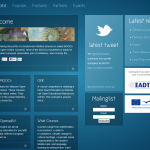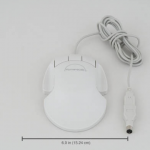The U.S National Institutes of Health has launched a 3D print exchange website that allows users to download, edit and share models of anatomy, bacteria and lab equipment. Among the current available selections: a frog dissection kit, the base of a cervical spine, a bust of a Macaque, the influenza virus, a microscope, a DNA playset and a “three-dimensional structure of the toxin-delivery particle antifeeding prophage of Serratia entomophila.”
Tag Archives: Learning resources
OpenupEd – the European MOOCs portal
 A European portal of MOOCs (Massive Open Online Courses) was recently launched at www.openuped.eu. It offers online courses, free of charge, in different languages from partner universities in Europe. The subjects cover from learning skills, management, climate change to mathematics. If you are interested in how a topic is taught in Europe or something outside of your curriculum , take a course at this website. Other major MOOCs providers include Coursera, Udacity, edX.
A European portal of MOOCs (Massive Open Online Courses) was recently launched at www.openuped.eu. It offers online courses, free of charge, in different languages from partner universities in Europe. The subjects cover from learning skills, management, climate change to mathematics. If you are interested in how a topic is taught in Europe or something outside of your curriculum , take a course at this website. Other major MOOCs providers include Coursera, Udacity, edX.
The Universal Design Product Collection at State University of New York at Buffalo Libraries
 State University of New York at Buffalo Libraries have a digital collection for universal design products. Some of them are quite interesting, for example, the mouse in the right side illustration. It looks like a regular mouse, but it is much larger than the normal one so that it “fits the palm of the hand and does not require bending of the fingers.” If your hands are sometimes tired of holding the mouse after being in front of the computer for hours, you may want to try out this flat mouse.
State University of New York at Buffalo Libraries have a digital collection for universal design products. Some of them are quite interesting, for example, the mouse in the right side illustration. It looks like a regular mouse, but it is much larger than the normal one so that it “fits the palm of the hand and does not require bending of the fingers.” If your hands are sometimes tired of holding the mouse after being in front of the computer for hours, you may want to try out this flat mouse.
 I also noticed this wiggly and giggly ball. It “wiggles and giggles when it moves”, so it can encourage babies to follow (learn to crawl!) even before they can actually crawl.
I also noticed this wiggly and giggly ball. It “wiggles and giggles when it moves”, so it can encourage babies to follow (learn to crawl!) even before they can actually crawl.
Happy viewing!
Images from the Universal Design Product Collection at State University of New York at Buffalo Libraries
Reading journal articles
I have had a few interesting discussions with students about reading journal articles. Specifically, we discussed how to read journal articles in order to make them understandable and how to extract relevant information from the contents of an article. There is a great online tutorial from Purdue University Libraries that explains How to Read a Scientific Paper, which I find useful for both teaching and learning this subject.
Equal access to learning materials for STEM students across the globe
It’s not always easy to scratch together the money to buy an expensive textbook, and the Library does a lot to help ease the burden of those costs by buying and placing many textbooks on reserve and buying the electronic version when available. That said, it can be tough to get that reserve copy and sharing textbook costs with classmates is effective but not an all-out solution.
 Autar Kaw, a mechanical engineering professor at the University of South Florida, is sensitive to the realities of how much learning materials cost. With grant money from the National Science Foundation (NSF), he has been able to turn his vision of equitable access for all into a reality. Kaw created a free, open courseware resource called Holistic Numerical Methods, promoting free access to math instruction. “Available to students across the globe, the jam-packed site offers video lectures, simulations, textbook chapters, PowerPoint presentations, multiple choice tests and worksheets to learn concepts in numerical methods (an approach that allows scientists and engineers to arrive at approximate solutions for mathematical models of problems they can’t solve exactly or that would take too long to solve).” Click here to read more about Autar Kaw, his open courseware initiatives, and his philosophies surrounding the integration of online resources with in-class instruction, along with some of the pitfalls of the ever popular Massive Open Online Courses (MOOCs).
Autar Kaw, a mechanical engineering professor at the University of South Florida, is sensitive to the realities of how much learning materials cost. With grant money from the National Science Foundation (NSF), he has been able to turn his vision of equitable access for all into a reality. Kaw created a free, open courseware resource called Holistic Numerical Methods, promoting free access to math instruction. “Available to students across the globe, the jam-packed site offers video lectures, simulations, textbook chapters, PowerPoint presentations, multiple choice tests and worksheets to learn concepts in numerical methods (an approach that allows scientists and engineers to arrive at approximate solutions for mathematical models of problems they can’t solve exactly or that would take too long to solve).” Click here to read more about Autar Kaw, his open courseware initiatives, and his philosophies surrounding the integration of online resources with in-class instruction, along with some of the pitfalls of the ever popular Massive Open Online Courses (MOOCs).
Photo Courtesy of Aimee Blodgett/USF
BiblioTech: An audio podcast series about emerging technologies for academics
 I came across an interesting monthly series by Rochelle Mazar, an Emerging Technologies Librarian at the University of Toronto Mississauga, about new technologies for faculty, instructors, and researchers. Topics covered include: information overload, productivity tools, digital natives, wikipedia, plagiarism, etc. Check out her latest podcast and previous episodes on the University Affairs website.
I came across an interesting monthly series by Rochelle Mazar, an Emerging Technologies Librarian at the University of Toronto Mississauga, about new technologies for faculty, instructors, and researchers. Topics covered include: information overload, productivity tools, digital natives, wikipedia, plagiarism, etc. Check out her latest podcast and previous episodes on the University Affairs website.
Image from Daniel Johnson Jr. (Flickr)
The power of AND, OR, NOT
The search commands, AND, OR, NOT, (also known as Boolean operators, named after its British mathematician inventor, George Boole) can be used to combine your words in many search engines and research databases. Here’s a short video that explains how to use AND, OR, NOT when searching:
Google’s role in term paper research
I found this brief video, which clearly explains why Googling your topic is not enough when you need to do research for a paper:
https://youtu.be/N39mnu1Pkgw
Scientific and technical writing
 I recently attended an information session for civil engineering students enrolled in a one credit technical writing course. The students must write a fifteen page technical paper on a civil engineering topic of their choice. They will be graded on content, organization, paper presentation, and quality of writing. The benefits of being able to write well cannot be overstated. Students who are preparing for a career in a technical profession might not appreciate how important writing skills are. Without strong writing skills, it will be difficult to advance in your career. McGill Library has a great selection of writing and style guides, specifically for science and engineering students. Below are some examples:
I recently attended an information session for civil engineering students enrolled in a one credit technical writing course. The students must write a fifteen page technical paper on a civil engineering topic of their choice. They will be graded on content, organization, paper presentation, and quality of writing. The benefits of being able to write well cannot be overstated. Students who are preparing for a career in a technical profession might not appreciate how important writing skills are. Without strong writing skills, it will be difficult to advance in your career. McGill Library has a great selection of writing and style guides, specifically for science and engineering students. Below are some examples:
1. The ACS style guide: effective communication of scientific information
2. Making sense: a student’s guide to research and writing : engineering and the technical sciences
3. Pocket book of technical writing for engineers and scientists
4. Style and ethics of communication in science and engineering (eBook)
And be sure to visit the McGill Library webpage, Writing tools, where you will find links to resources on topics ranging from grammar to academic integrity.
Image from www.blogs.discovermagazine.com
Learning LaTeX online
I recently had to learn some basics about LaTeX, which is free software used to create professionally typeset documents. Its strength lies in formatting technical and scientific documents that contain mathematical notations.
Below are links to some short videos that are useful for learning how to use LaTeX:
Image from Microsoft Office Clipart
